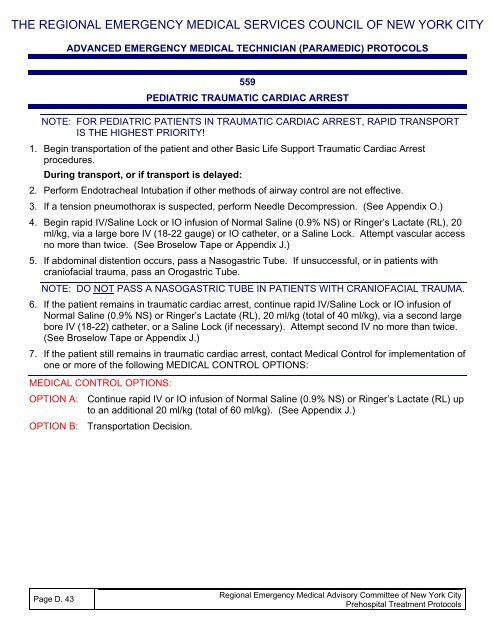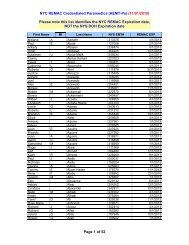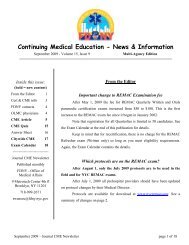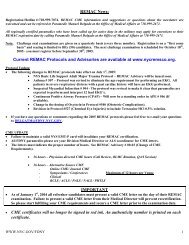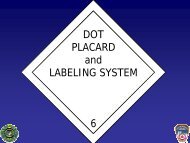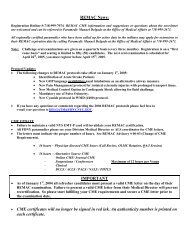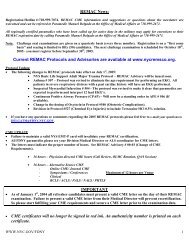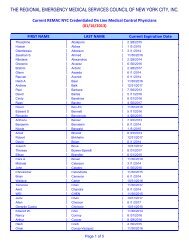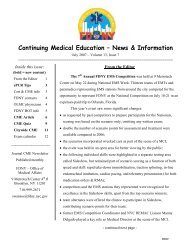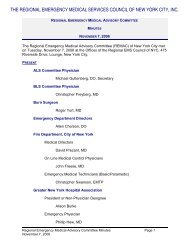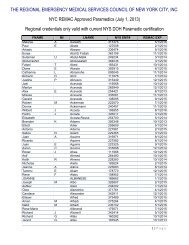prehospital treatment protocols - The Regional Emergency Medical ...
prehospital treatment protocols - The Regional Emergency Medical ...
prehospital treatment protocols - The Regional Emergency Medical ...
You also want an ePaper? Increase the reach of your titles
YUMPU automatically turns print PDFs into web optimized ePapers that Google loves.
THE REGIONAL EMERGENCY MEDICAL SERVICES COUNCIL OF NEW YORK CITYADVANCED EMERGENCY MEDICAL TECHNICIAN (PARAMEDIC) PROTOCOLS559PEDIATRIC TRAUMATIC CARDIAC ARRESTNOTE: FOR PEDIATRIC PATIENTS IN TRAUMATIC CARDIAC ARREST, RAPID TRANSPORTIS THE HIGHEST PRIORITY!1. Begin transportation of the patient and other Basic Life Support Traumatic Cardiac Arrestprocedures.During transport, or if transport is delayed:2. Perform Endotracheal Intubation if other methods of airway control are not effective.3. If a tension pneumothorax is suspected, perform Needle Decompression. (See Appendix O.)4. Begin rapid IV/Saline Lock or IO infusion of Normal Saline (0.9% NS) or Ringer’s Lactate (RL), 20ml/kg, via a large bore IV (18-22 gauge) or IO catheter, or a Saline Lock. Attempt vascular accessno more than twice. (See Broselow Tape or Appendix J.)5. If abdominal distention occurs, pass a Nasogastric Tube. If unsuccessful, or in patients withcraniofacial trauma, pass an Orogastric Tube.NOTE: DO NOT PASS A NASOGASTRIC TUBE IN PATIENTS WITH CRANIOFACIAL TRAUMA.6. If the patient remains in traumatic cardiac arrest, continue rapid IV/Saline Lock or IO infusion ofNormal Saline (0.9% NS) or Ringer’s Lactate (RL), 20 ml/kg (total of 40 ml/kg), via a second largebore IV (18-22) catheter, or a Saline Lock (if necessary). Attempt second IV no more than twice.(See Broselow Tape or Appendix J.)7. If the patient still remains in traumatic cardiac arrest, contact <strong>Medical</strong> Control for implementation ofone or more of the following MEDICAL CONTROL OPTIONS:MEDICAL CONTROL OPTIONS:OPTION A: Continue rapid IV or IO infusion of Normal Saline (0.9% NS) or Ringer’s Lactate (RL) upto an additional 20 ml/kg (total of 60 ml/kg). (See Appendix J.)OPTION B: Transportation Decision.Page D. 43<strong>Regional</strong> <strong>Emergency</strong> <strong>Medical</strong> Advisory Committee of New York CityPrehospital Treatment Protocols


